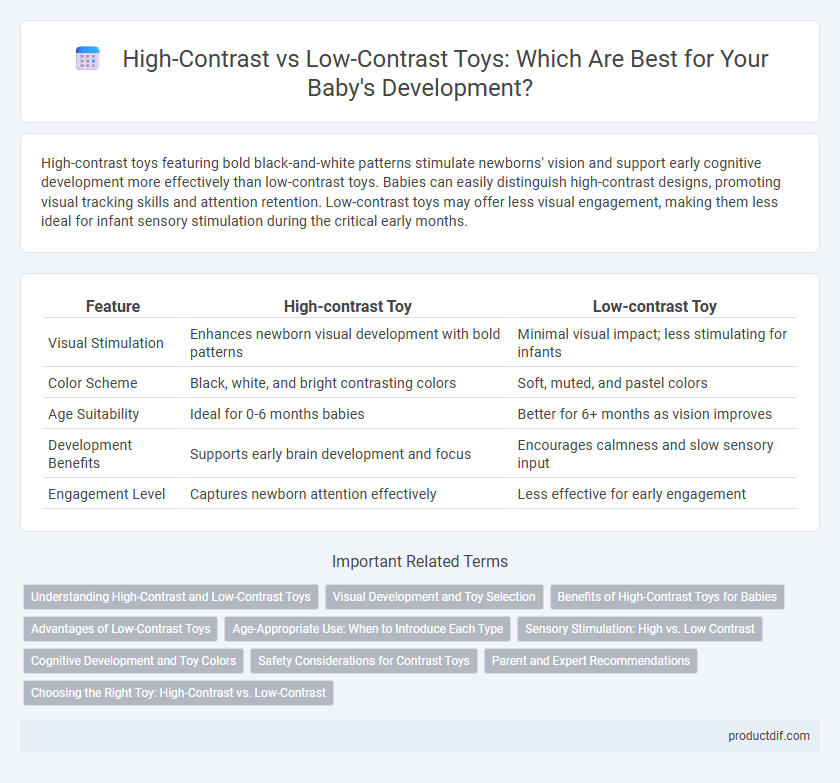High-contrast toys featuring bold black-and-white patterns stimulate newborns' vision and support early cognitive development more effectively than low-contrast toys. Babies can easily distinguish high-contrast designs, promoting visual tracking skills and attention retention. Low-contrast toys may offer less visual engagement, making them less ideal for infant sensory stimulation during the critical early months.
Table of Comparison
| Feature | High-contrast Toy | Low-contrast Toy |
|---|---|---|
| Visual Stimulation | Enhances newborn visual development with bold patterns | Minimal visual impact; less stimulating for infants |
| Color Scheme | Black, white, and bright contrasting colors | Soft, muted, and pastel colors |
| Age Suitability | Ideal for 0-6 months babies | Better for 6+ months as vision improves |
| Development Benefits | Supports early brain development and focus | Encourages calmness and slow sensory input |
| Engagement Level | Captures newborn attention effectively | Less effective for early engagement |
Understanding High-Contrast and Low-Contrast Toys
High-contrast toys feature bold, distinct patterns in black, white, and primary colors that stimulate newborns' developing vision and enhance cognitive recognition. Low-contrast toys use softer, pastel shades and subtle patterns that promote gentle sensory exploration and soothing engagement for older infants. Understanding the differences helps caregivers select age-appropriate toys that support visual development and sensory processing effectively.
Visual Development and Toy Selection
High-contrast toys featuring bold black-and-white patterns stimulate infant visual development by enhancing focus and tracking abilities during critical early months. In contrast, low-contrast toys with muted colors offer subtle sensory engagement suitable for older babies refining color recognition and detail perception. Selecting age-appropriate toys that match developmental stages supports optimal visual and cognitive growth in infants.
Benefits of High-Contrast Toys for Babies
High-contrast toys, featuring bold patterns in black, white, and bright colors, significantly enhance visual development in infants by stimulating their limited color perception and focusing abilities. These toys promote cognitive growth by encouraging babies to track shapes and contrasts, which supports early neural connections and visual recognition skills. Choosing high-contrast toys can improve attention span and sensory exploration, leading to better overall developmental milestones in the critical first months.
Advantages of Low-Contrast Toys
Low-contrast toys offer a calming visual experience that supports early visual development by reducing overstimulation in infants. These toys enhance focus and attention by providing subtle differences in color and pattern, which align with a newborn's limited color perception. Low-contrast toys also promote better sleep patterns as their gentle appearance creates a soothing environment for babies.
Age-Appropriate Use: When to Introduce Each Type
High-contrast toys are ideal for newborns and infants up to 6 months old, as their developing vision is more responsive to bold patterns and stark color differences. Low-contrast toys become more stimulating and suitable once babies reach around 6 to 12 months, as their color perception and focus sharpen. Introducing high-contrast toys earlier supports visual development, while low-contrast toys enhance cognitive and sensory skills during later stages.
Sensory Stimulation: High vs. Low Contrast
High-contrast toys featuring bold black-and-white patterns significantly enhance sensory stimulation in infants by promoting visual development and maintaining attention. Low-contrast toys with muted colors provide gentler sensory experiences that may be less effective in engaging newborns' visual systems during early development stages. Choosing high-contrast toys supports enhanced neural connections and cognitive growth through increased visual engagement and focus.
Cognitive Development and Toy Colors
High-contrast toys featuring bold black-and-white patterns significantly enhance newborns' visual stimulation and cognitive development by improving their focus and pattern recognition. In comparison, low-contrast toys with pastel or muted colors are less effective in early cognitive engagement but become more suitable as infants develop color vision around 3-4 months. Incorporating high-contrast colors in baby toys supports neural connections and visual processing skills critical in the first months of life.
Safety Considerations for Contrast Toys
High-contrast toys, featuring black-and-white or bold color patterns, enhance infant visual development by stimulating the brain's visual pathways more effectively than low-contrast toys. Safety considerations emphasize the use of non-toxic materials and ensuring that toys have no small parts to prevent choking hazards, regardless of contrast level. Selecting high-contrast toys with soft, durable fabrics and secure stitching reduces the risk of injury while promoting sensory engagement.
Parent and Expert Recommendations
Experts recommend high-contrast toys for infants because their developing vision is more responsive to bold patterns and distinct colors, which stimulate cognitive and visual development. Parents are encouraged to choose toys featuring black, white, and primary colors to enhance sensory engagement and promote early recognition skills. Low-contrast toys may be less effective in capturing a baby's attention and supporting neural growth during critical developmental stages.
Choosing the Right Toy: High-Contrast vs. Low-Contrast
High-contrast toys, featuring bold black-and-white patterns, stimulate newborns' developing vision and support early cognitive growth, making them ideal during the first months. Low-contrast toys, with softer colors and patterns, are better suited for older infants as their vision improves, promoting fine motor skills and sensory exploration. Selecting the appropriate contrast level ensures optimal visual engagement and developmental benefits tailored to your baby's age.
High-contrast Toy vs Low-contrast Toy Infographic

 productdif.com
productdif.com